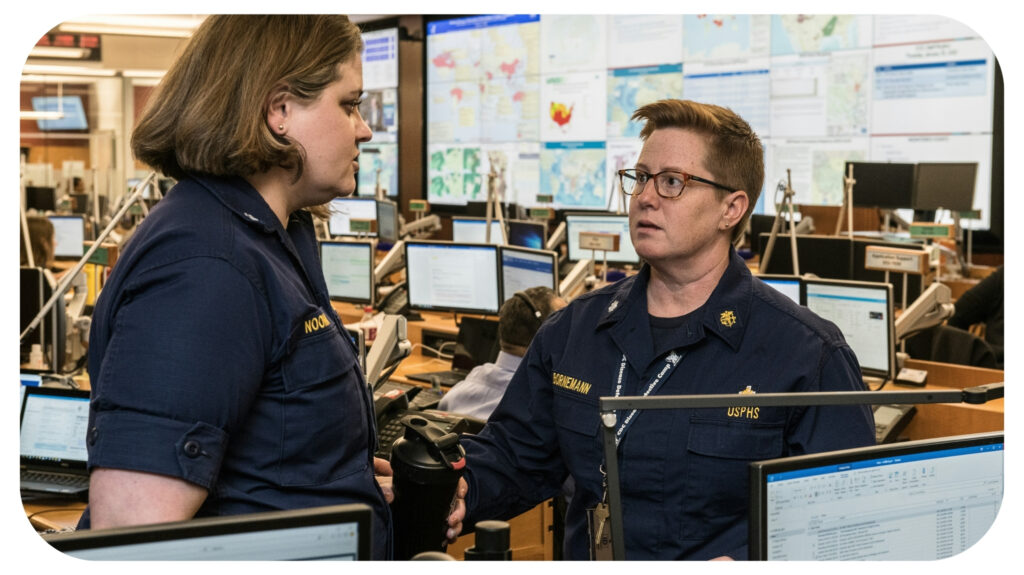Leadership in Crisis: Managing Teams During Disaster Relief Operations

Disaster relief operations require swift, decisive action and strong leadership to navigate the complex challenges of crisis situations. In such high-stakes environments, effective leaders must balance urgent decision-making, clear communication, and team coordination, often with limited resources and time. Managing diverse, multidisciplinary teams under pressure adds to the complexity, making leadership a critical factor in determining success.
This article explores key leadership strategies that can help guide teams through the chaos of disaster relief, emphasizing the essential qualities and skills leaders need to ensure efficient, compassionate, and impactful responses during times of crisis.
Key Qualities of Effective Leaders in Crisis
In disaster relief operations, effective leadership is defined by a combination of essential qualities that enable leaders to navigate high-pressure situations and guide their teams toward successful outcomes.
According to Madhu Rajan, an innovator in crisis management, “Effective crisis leadership hinges on the ability to adapt swiftly, make decisive choices under pressure, communicate with clarity, and maintain resilience in the face of adversity. These qualities not only steer teams through chaos but also transform challenges into opportunities for impactful action.”
Adaptability is crucial, as conditions on the ground can change rapidly. Leaders must be able to adjust their strategies in real time, responding to evolving challenges and shifting priorities. Whether it’s handling logistical delays, unexpected shortages, or new threats, flexibility is key to keeping operations moving forward.
Decision-making under pressure is another critical skill. In a crisis, leaders often have to make fast, high-stakes decisions with incomplete information. The ability to assess risks, prioritize actions, and commit to choices confidently is essential for maintaining momentum in disaster response.
Communication skills are equally important. Clear, concise, and consistent communication is necessary to ensure that all team members understand their roles, responsibilities, and the overall mission. In times of crisis, misinformation or confusion can lead to delays and even jeopardize lives.
Finally, resilience plays a pivotal role. Leaders must manage their own stress while keeping team morale high. A resilient leader can maintain focus and inspire others to push through setbacks, fostering a sense of unity and purpose in the face of adversity.
Leading a Multidisciplinary Team
Disaster relief operations require leaders to manage teams composed of diverse professionals, such as medical staff, engineers, logistics experts, and volunteers. Each member brings specialized knowledge and skills, which are critical for the success of the operation. However, leading a multidisciplinary team presents unique challenges that demand effective coordination and a unifying vision.
One of the primary tasks of a leader in this context is to leverage the expertise of each team member. Leaders must understand the strengths and limitations of different disciplines and how they contribute to the larger mission. This involves facilitating collaboration across various fields, ensuring that experts can work together to solve problems efficiently. Creating an environment of open communication and mutual respect is essential for minimizing conflicts and maximizing cooperation.
Additionally, a strong leader must clearly define roles and responsibilities to avoid confusion or duplication of efforts. In the chaos of a disaster, it’s easy for teams to lose focus or overlap in their duties, which can lead to inefficiencies or critical oversights. Leaders must provide clear guidance and direction, emphasizing a shared goal and aligning the team’s actions toward that outcome.
By fostering collaboration, clarity, and a sense of purpose, leaders can harness the strengths of a multidisciplinary team to deliver effective disaster relief.

Communication in Disaster Relief
Effective communication is the backbone of successful disaster relief operations. In crisis situations, where time is limited and conditions are rapidly evolving, leaders must ensure that information flows smoothly and accurately both within the team and to external stakeholders.
Real-time communication is critical for coordinating efforts. Team members need to be updated on new developments, shifting priorities, and resource availability. Leaders must ensure that instructions are clear, concise, and actionable, minimizing the chance of misunderstandings that could delay operations or put lives at risk. Consistent check-ins and the use of reliable communication technologies are essential tools to keep everyone aligned.
Leaders also need to manage external communication, especially with stakeholders such as government agencies, humanitarian organizations, and the media. Clear communication with these entities ensures that the team has the support and resources they need. Furthermore, it helps build trust with affected populations, demonstrating that help is on the way and efforts are coordinated.
Another challenge in communication during disaster relief is mitigating misinformation. In times of crisis, rumors and inaccurate reports can spread quickly, creating confusion and panic. Leaders must address misinformation swiftly, providing accurate, timely updates to maintain control of the situation and keep team efforts focused.
Decision-Making Strategies in High-Stress Environments
Disaster relief operations place leaders in situations where quick and effective decision-making is crucial. In these high-stress environments, leaders must balance urgency with accuracy, often making critical choices with incomplete or evolving information.
One key strategy is to adopt rapid, yet informed decision-making. Leaders must assess available data swiftly, prioritize tasks, and act decisively. However, this doesn’t mean reckless haste; rather, it involves recognizing when decisions need to be made quickly to maintain momentum and when it’s essential to gather more information before committing to a course of action.
Delegation is another vital aspect of decision-making in crises. Leaders cannot make every decision themselves, especially in complex operations. Trusting team members to make tactical decisions within their areas of expertise allows the leader to focus on broader strategy. Empowering team members fosters a sense of ownership and enables quicker action on the ground.
A strong leader also employs risk assessment and prioritization techniques. Not every problem can be solved at once, and in disaster relief, resources are often scarce. Leaders must identify the most pressing needs, such as saving lives or stabilizing critical infrastructure, and direct their teams accordingly. Prioritizing effectively can make the difference between success and failure in disaster relief efforts.
“In high-stress disaster relief operations, leaders must balance rapid decision-making with thoughtful prioritization,” says Madhu Rajan. “The key is to act swiftly while trusting your team’s expertise to handle the immediate challenges, allowing you to focus on the bigger picture. Effective delegation and clear prioritization can turn chaos into coordinated, life-saving efforts.”
Effective leadership is critical in disaster relief operations, where the stakes are high, and the challenges are immense. Leaders in these situations must be adaptable, able to make swift decisions, and excel in communication, guiding multidisciplinary teams toward a common goal despite chaos and uncertainty. By cultivating these key qualities, leaders can navigate the complexities of disaster relief while maintaining team morale and ensuring that operations stay on track.
Equally important is the ability to leverage the diverse skills within a team, ensuring collaboration and clear role definitions. Communication, both internally and externally, plays a central role in preventing misinformation, maintaining transparency, and keeping all parties aligned with the mission. Leaders must also make tough decisions, balancing risk and resource allocation while trusting their teams to execute tasks efficiently.
Ultimately, leadership in disaster relief is about more than managing logistics—it’s about providing a steady hand during moments of crisis. Effective leaders not only solve immediate problems but also inspire confidence, resilience, and unity among their teams. In the face of unpredictable challenges, strong leadership can make a profound difference in the success of a disaster response, turning chaos into coordinated action that saves lives and restores hope.
Recommended For You
A Guide to Building an Applicant Tracking System for Recruiting Agencies
Most Inside
Most Inside offers high-quality recommendations and valuable updates to enhance all aspects of your life, providing premium guidance and enriching experiences.



